Kite Surfing in San Diego: A Comprehensive Exploration

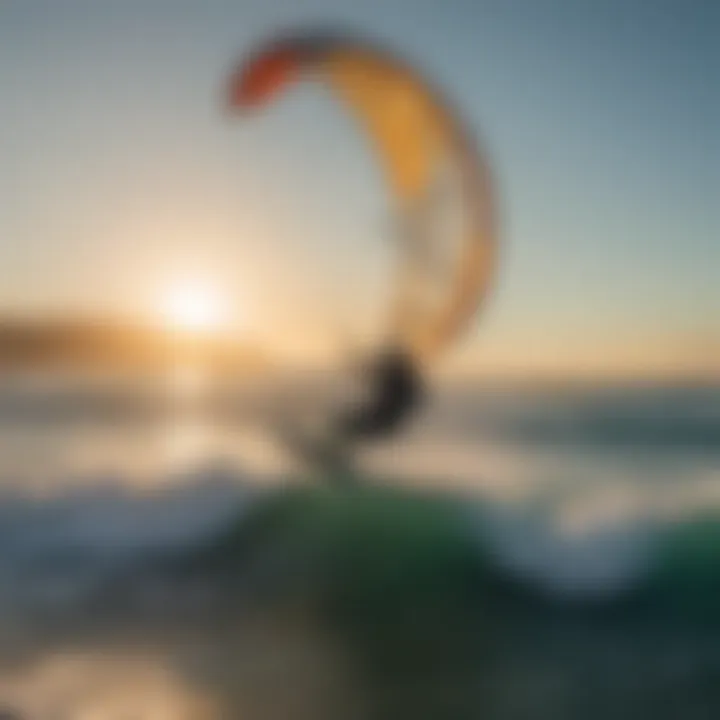
Intro
Kite surfing is rapidly growing in popularity, especially in diverse locations like San Diego. The city’s stunning coastlines and favorable weather create a perfect environment for kite enthusiasts. The sport combines aspects of surfing and kite flying, drawing both thrill-seekers and those who enjoy the ocean.
This article seeks to provide a thorough examination of kite surfing in San Diego, catering to both newcomers and seasoned veterans of the sport. We will explore essential equipment, the best spots to surf, as well as techniques for improving your skills. Safety is also a critical aspect that we will cover in depth. With our focus on San Diego, readers will gain insight into what makes this location a top choice for kite surfing.
Equipment Reviews
Selecting the right equipment is vital for an enjoyable kite surfing experience. The evolution of gear has led to advancements in performance and safety. This section will cover the primary components involved in kite surfing: kites, boards, and accessories.
Kites
Kites are the primary means of propulsion in kite surfing. The latest models vary significantly in design and capabilities. When choosing a kite, consider the shape, size, and materials.
- Kite Shapes: The two main categories are C-shaped and bow kites. C-kites provide excellent control for tricks, while bow kites are more versatile for beginners.
- Sizes: Smaller kites offer more control in strong winds, while larger ones capture more wind in lighter conditions.
- Materials: High-quality materials enhance durability and performance. Brands like North Kiteboarding and Naish have a solid reputation for reliability and innovation.
Boards
Kiteboards are equally important as they affect how you ride. The two main types of boards are twintips and directional boards.
- Twintip Boards: Ideal for flat water and beginner-friendly, they facilitate easy riding in both directions.
- Directional Boards: Suited for wave riding, they provide different experiences and require more advanced skills.
Assessing construction and design will help in choosing the right board that fits your riding style and conditions.
Accessories
Kite surfing accessories play a notable role in the overall safety and enjoyment of the sport. Consider the following key pieces:
- Harnesses: Proper harnesses distribute force on your body, allowing for prolonged kite handling.
- Lines: High-quality lines are essential for control. Look for those that offer minimal stretch.
- Pumps: Reliable pumps facilitate quick kite inflation.
- Safety Gear: This includes life jackets, helmets, and impact vests. Their use significantly reduces risk while on the water.
Each accessory serves a unique purpose, ultimately enhancing the kite surfing experience.
Travel Destinations
Kite surfing is not limited to San Diego alone, but various global locations offer unique experiences. Understanding these can expand your horizons.
Popular Spots
World-renowned kite surfing locations like Cape Town and the Caribbean cater to all skill levels. Each destination offers different wind and water conditions.
- Cape Town, South Africa: Known for its strong winds and extensive beaches. Local amenities make it ideal.
- Tarifa, Spain: Offers reliable winds, making it a hotspot for many surfers.
Off the Beaten Path
For those seeking less crowded spots, consider locations like Pismo Beach in California or the lagoons in Brazil. Both offer breathtaking views and unique riding experiences, often having fewer surfers around.
Techniques and Tutorials
Improving kite surfing skills requires practice and understanding of techniques. This section provides guidance for both beginners and experienced surfers.
Beginner Guides
For novices, understanding basic maneuvers is essential. Key techniques include:
- Launching: Ensure the kite is positioned correctly to catch wind.
- Riding: Maintain balance and control as you glide.
- Turning and Landing: Gradually learn to change directions and land safely.
Advanced Skills
Experienced surfers can further refine their skills with advanced techniques:
- Jumps and Tricks: Focus on timing and technique for more complex maneuvers.
- Wave Riding: Understanding swell and tides is crucial for riding waves effectively.
Safety Guidelines
Safety is paramount in kite surfing. Understanding environmental conditions and proper protocols can prevent accidents.
Weather Conditions
Before kite surfing, consider wind speed, tide patterns, and any local weather warnings. Changing conditions can significantly affect safety.
Emergency Protocols
It is wise to familiarize yourself with rescue tactics. Knowledge of basic emergency procedures can make a difference in critical situations.
Equipment Maintenance
Regular checks and maintenance of your gear ensure reliability. Inspect for wear and tear often. Ensure your safety gear meets established standards to mitigate risks.
By covering these aspects, this article aims to provide a robust understanding of kite surfing in San Diego, while highlighting the sport’s growth and the vibrant community that supports it.
Kite surfing challenges the body and elevates the spirit, making it a must-try experience for aquatic adventurers.
With proper preparation and knowledge, kite surfing in San Diego can be both thrilling and safe.
Preface to Kite Surfing


Kite surfing has gained considerable recognition in recent years, not only as an exhilarating water sport but also as a unique blend of skills that demands precision and coordination. This section provides an introduction to kite surfing, laying the foundation for understanding why this sport draws enthusiasts from all walks of life—particularly in picturesque locations like San Diego.
The importance of understanding kite surfing lies in its rich combination of adventure and technique. Kite surfing incorporates aspects of both surfing and aerial sports. Many see it as an outlet for expression and freedom, a way to connect with nature while simultaneously challenging one’s physical and mental limits. Each kite surfer learns not just how to maneuver the kite, but also the dynamics of wind, water, and movement. The sport's multifaceted nature requires dedication and awareness, making it appealing to those who crave challenge and excitement.
In San Diego, the unique topography and favorable weather conditions create an ideal backdrop for this sport. With its coastline stretching across the Pacific Ocean, San Diego provides a variety of spots where conditions often align perfectly for kite surfers.
What is Kite Surfing?
Kite surfing is a sport that combines elements of surfing, windsurfing, and paragliding. As an athlete rides on a board—similar to a surfboard or wakeboard—the individual is pulled along by a large, controllable kite. The kite harnesses wind power and translates this into movement across the water.
The process involves significant coordination, as it requires the kite surfer to manage both the speed of the kite and their own balance on the board. Kite surfers use a control bar connected to the kite via lines that allow them to manipulate the kite's direction and power. It can be done in various locations, from flat water to ocean waves, making it adaptable to different preferences and skill levels.
For those interested in participation or viewing, understanding what kite surfing entails is foundational. This sport offers not just physical engagement, but also a community experience as enthusiasts often share locations, techniques, and equipment recommendations.
Brief History of the Sport
The history of kite surfing can be traced back to the late 20th century, where early prototypes began emerging. The sport's evolution took significant steps with developments in the early 1980s, as pioneers experimented with various kite designs and board types.
In those early years, kites were extremely different compared to today’s variations. Designs evolved from modified windsurfing sails to freeride kites capable of executing jumps and tricks. By the 1990s, with the introduction of reliable safety features and stable kite designs, kite surfing started to gain traction globally.
Today, kite surfing continues to grow in popularity, with advancements in technology contributing to its accessibility and safety. Numerous competitions now occur worldwide, underscoring not only the sport's skill-based nature but its cultural relevance. Places like San Diego have embraced this sport, providing a space for both professionals and novices to engage with their surroundings while enjoying the thrill of flying across water.
San Diego: A Prime Location for Kite Surfing
San Diego stands out as a prime location for kite surfing due to its favorable geographical features and climate conditions. Its extensive coastline offers various spots with different conditions, making it suitable for both novice and experienced kite surfers. With its stunning beaches and clear waters, San Diego provides an ideal backdrop for outdoor sports enthusiasts.
Geographical Overview
The geography of San Diego plays a crucial role in its kite surfing appeal. The region features a variety of terrains, including sandy beaches, lagoons, and open ocean waters.
- Mission Bay: This area is especially popular due to its calm waters, which provide a safer environment for beginners.
- La Jolla Shores: Known for its breathtaking scenery, this spot offers ocean swells that challenge skilled riders.
- Ocean Beach: Here, surfers can experience powerful waves and dynamic wind conditions, ideal for advanced techniques.
The diverse locations enable kite surfers to choose a spot that aligns with their skill level and desired experience. Additionally, the access to amenities and rental services adds convenience for those visiting the area.
Climate Considerations
San Diego's climate further enhances its suitability for kite surfing. The region enjoys a Mediterranean climate characterized by warm, dry summers and mild winters. This leads to consistent wind patterns, which are essential for kite surfing.
- Wind Patterns: The dominant winds during the summer months, known as the "Santa Ana Winds," provide ideal conditions for kite surfers looking to enjoy their sport.
- Temperature: The water temperature averages between 60 and 70 degrees Fahrenheit, allowing for comfortable sessions throughout the year.
- Sunny Days: With over 260 sunny days annually, San Diego attracts kite surfers all year long.
This combination of geographical features and favorable climate conditions not only makes San Diego an attractive destination for kite surfing but also contributes to a vibrant local culture that celebrates outdoor sports.
Popular Kite Surfing Locations in San Diego
San Diego offers an array of exceptional kite surfing locations. These spots not only cater to various skill levels but also are enriched by the local environment. Choosing the right place can significantly affect one’s experience. Factors like wind patterns, waves, and space for maneuvering play a crucial role in kite surfing enjoyment. Here, we dive into three main locations that kite surfers often frequent, each presenting unique characteristics and advantages.
Mission Bay
Mission Bay is a hub for both beginners and seasoned kite surfers. The protected waters of the bay provide a safe environment for learners to practice without the threats of strong waves. This location is especially appealing due to its consistent wind patterns that make for ideal conditions, typically from spring to fall.
The layout among palm trees and sandy beaches offers beautiful scenery that enhances the surfing experience. Kite surfers can often find local schools conducting lessons, making it easier for newcomers to get the guidance they need. The spaciousness of the bay allows for safe navigation and less crowding.
La Jolla Shores
La Jolla Shores is another favourite spot among kite surfing enthusiasts. This beach is known for its beautiful long shoreline and excellent wind conditions. It attracts a mix of surfers, beachgoers, and marine life enthusiasts. The waves can be slightly more challenging than those at Mission Bay, which can be appealing for more experienced kite surfers looking for excitement.
The nearby La Jolla Cove adds to the beauty of this location, providing a stunning backdrop while engaging with the surf. However, safety is crucial as the waters can be unpredictable, especially with tides. Kite surfers should always remain cautious and aware of their surroundings.
Ocean Beach
Ocean Beach caters to a vibrant kite surfing community. Known for its strong winds and waves, this location is more suited for advanced surfers. The beach often hosts local competitions, making it a hotspot for skilled kite surfers to showcase their talents. The lively atmosphere filled with like-minded individuals creates a sense of community.
The challenges of Ocean Beach come from its strong currents and wave conditions, which can be risky for those not prepared. As with La Jolla Shores, it's important for surfers to be aware of weather changes and ocean behaviors. Knowledge of tidal patterns can make or break a successful surf session.
"Choosing the right location is essential not just for the enjoyment but also for safety and skill enhancement."
In each of these locations, kite surfers can find unique opportunities to improve their skills, socialize with other enthusiasts, and enjoy their time on the water. Each spot presents its own set of challenges and advantages, ensuring that there is something for everyone.
Essential Gear for Kite Surfing
Equipping oneself with the right gear is crucial in kite surfing for both safety and performance. The dedication to selecting appropriate equipment makes a significant difference, especially for beginners. Proper gear not only enhances the surfing experience but also addresses safety concerns and comfort.
Kites: Types and Sizes
Kites are the core part of the kite surfing experience. There are various types of kites, like inflatable kites and foil kites. Inflatable kites are more common due to their ease of use and stability.
When choosing kites, understanding size is essential. Sizes typically range from 3 to 17 square meters. A smaller kite works better in high wind conditions, while larger kites are suited for lighter winds. It is advisable to have multiple sizes if possible to adapt to changing weather conditions.
Consider these factors while choosing kites:
- Wind Range: Know the wind conditions of San Diego to select an appropriate size.
- Skill Level: Beginners might prefer stable kites that are easy to control.
- Style of Riding: Different styles may require specific kite designs.
Boards: Choosing the Right One
Boards are equally vital, directly impacting maneuverability and speed on water. There are many types, including twin tip boards and directional boards. Twin tip boards are versatile for both regular and goofy stances and are great for tricks.
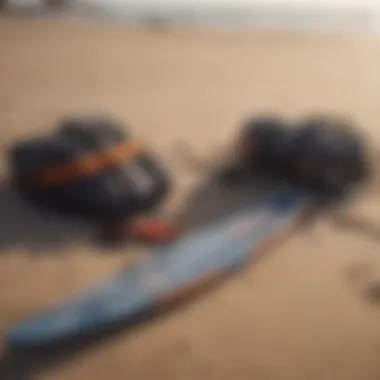
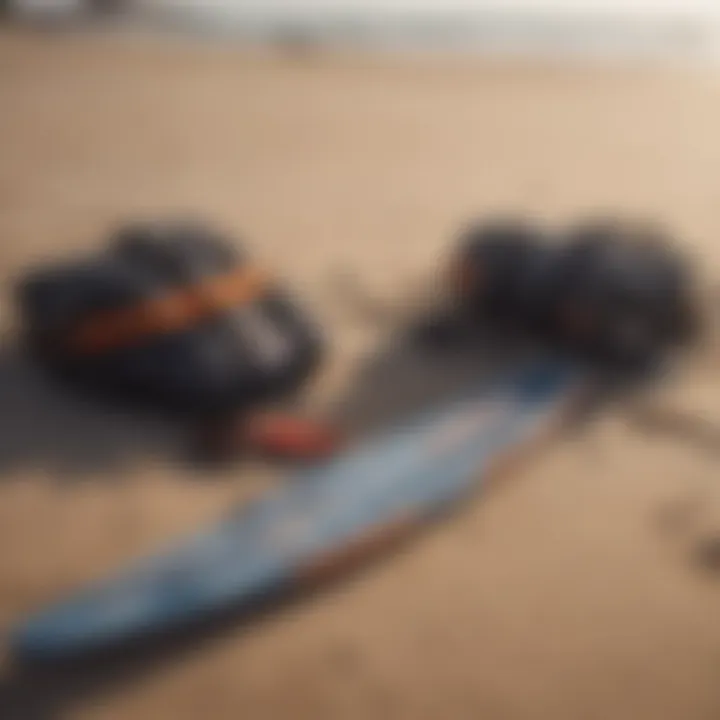
Key Considerations for Board Selection:
- Size: Heavier riders require larger boards for better buoyancy.
- Riding Style: Freestyle riders may prefer shorter boards, while wave surfers often benefit from longer boards.
- Skill Level: Beginners should seek boards with a larger surface area for easier balance and control.
Safety Equipment
Safety gear is indispensable in kite surfing. A good harness, helmet, and impact vest are essential for protecting against falls and harsh impacts. A harness provides support and helps distribute pull from the kite.
Important safety equipment includes:
- Helmet: Protects the head from injury.
- Impact Vest: Offers cushion in case of falls.
- Leash: Keeps the kite close during emergencies, preventing loss of control.
Proper safety measures cannot be ignored. Ensure that any gear purchased meets safety standards, as this will aid greatly in emergency situations on the water.
"Investing in quality equipment is investing in safety and performance that can enhance your kite surfing experience."
In summary, selecting the right kites, boards, and safety equipment can significantly improve every kite surfer’s performance while ensuring safety. Focus on getting gear that aligns with personal skill level and regional conditions, particularly the unique elements present in San Diego.
Safety Measures and Guidelines
Safety is paramount in kite surfing. It is critical to understand and prioritize safety measures for both personal well-being and the enjoyment of the sport. In kite surfing, unpredictable elements such as wind and water conditions can pose significant risks. Adhering to safety guidelines not only protects the surfer but also ensures the safety of others in the vicinity. Understanding the local environment and having a plan can make the difference between a thrilling experience and a dangerous situation.
Understanding Wind Conditions
Wind is the driving force behind kite surfing. Mastering wind conditions is essential for any kite surfer. It is necessary to analyze the weather forecast before heading out. Wind speed, direction, and consistency are key factors to consider. Ideal wind for kite surfing typically ranges between 12 to 25 knots. However, this can vary based on individual skill levels and kite sizes.
Additionally, the interaction between wind and local geographical features can create unique patterns. For instance, in San Diego, coastal winds often change throughout the day, influenced by temperature shifts and ocean currents. Surfers should familiarize themselves with patterns at specific locations.
It is advisable to pay attention to wind gusts, as they can significantly affect control. Surfers should not underestimate the importance of understanding how wind affects their equipment. This knowledge can prevent accidents and improve performance.
Navigating San Diego's Waterways
San Diego offers a variety of waterways for kite surfing, including bays and open ocean. Each area has its own specific challenges. For instance, Mission Bay has more sheltered waters, making it ideal for beginners. On the other hand, open ocean conditions may be more suitable for experienced surfers.
Surfers should always be aware of their surroundings, including potential obstacles like boats, swimmers, and other surfers. Additionally, varying tides can create strong currents, emphasizing the need to keep an eye on local tide charts. Navigating waterways involves understanding right-of-way rules, which are essential for sharing the water respectfully.
Using designated areas for launches and landings further enhances safety and reduces accidents. Surfers should also consider potential hazards unique to specific locations, such as marine wildlife or underwater structures. Always carry a map or guidance tool to navigate unfamiliar waters effectively.
Emergency Procedures
Preparation for emergencies can be critical. Despite taking all precautions, situations may still arise. Therefore, having a plan is necessary. Surfers should know basic rescue techniques and how to assist others in need.
Training in first aid and CPR is advisable for those engaging in kite surfing. In addition, familiarizing oneself with the nearest rescue services and their contact information can be beneficial. Moreover, wearing a life jacket increases safety in emergency scenarios. Using a quick-release system on kites can assist in freeing oneself from a compromised situation.
Surfers should also consider carrying a whistle or signal mirror to attract attention if needed. Familiarizing oneself with how to signal for help is another vital aspect of safety. It's important to practice these safety measures regularly, ensuring all participants are aware of their roles during a potential emergency.
"Safety is not just a guideline; it’s a mindset every kite surfer should embrace."
Techniques for Beginners
Kite surfing can be a thrilling yet daunting sport for newcomers. Understanding essential techniques is crucial for anyone looking to start. Mastering these foundational skills not only enhances safety but also boosts confidence in the water. A proficient understanding of kite control, becoming comfortable on the board, and knowing where to practice are significant elements that set the stage for a rewarding experience in kite surfing.
Basic Understanding of Kite Control
Kite control forms the backbone of kite surfing. It is the skill that enables a kitesurfer to handle the kite effectively, harnessing wind power for both speed and lift. Beginners must learn the basic operations, such as how to steer the kite and manage its positioning relative to the wind direction.
Proper body positioning while controlling the kite is also essential. The rider must keep the kite steady while adjusting their body weight according to the wind’s strength and direction. This enhances the rider's balance and reduces the risk of accidents. Regular practice with smaller kites in calm conditions helps build familiarity with the kite's response and refine control skills.
Getting Up on the Board
Once a kitesurfer grasps kite control, the next step is getting up on the board. This technique requires coordination between the kite's movements and the body’s actions. The process typically involves positioning the board correctly in the water and then performing a series of movements to get on it.
Riders should focus on how to position their feet properly in the foot straps and the importance of shifting their weight to help the board glide over the water. Practicing this technique in shallow water helps to build confidence, allowing beginners to experiment without the fear of falling into deep waters. A steady pull from the kite helps lift the rider while transferring body weight onto the board.
Practical Training Locations
Finding a good location to practice is crucial for beginners. San Diego offers several spots suited for novice kite surfers.
- Mission Bay: This area is known for its flat water and consistent winds, making it perfect for practice without overwhelming conditions.
- La Jolla Shores: The gentle waves here provide a good balance for kitesurfers to learn. It’s also scenic, adding to the overall experience.
- Ocean Beach: While it might be a bit challenging, with some experience gained, this location offers a chance for riders to experience more dynamic conditions.
Choosing the right setting allows beginners to engage with the sport comfortably. This smoothens their learning curve and enhances their overall experience in kite surfing.
Advanced Kite Surfing Techniques
Advanced kite surfing techniques are vital for any serious kite surfer aiming to enhance their skills and enjoy the sport at a higher level. Mastery of these techniques not only adds excitement to your sessions but also improves safety and control in varying conditions. As surfers become proficient in basic skills, they can transition to more complex maneuvers that highlight their abilities and confidence on the water.
Jumping and Tricks
Jumping is one of the most exhilarating aspects of kite surfing. This technique allows surfers to launch themselves into the air, performing various tricks that showcase their creativity and skill. The importance of jumping lies in its potential to transform an ordinary ride into an aerial display that engages both the surfer and spectators.
To execute a jump successfully, one must understand kite positioning and body movement. Here are some key considerations:
- Kite Positioning: The kite should be pulled back to the edge of the wind window before the jump, offering the most lift.
- Takeoff Technique: A proper edge hold combined with bending the knees at the last moment shoots the surfer upward.
- Landing: Control your descent by adjusting the kite position; a well-timed pull will stabilize your landing.
Surfers can explore tricks like the back loop, front loop, or even spins, adding flair to their practice. These jumps not only enhance enjoyment but also help build a stronger fundamentals for progression in kite surfing.
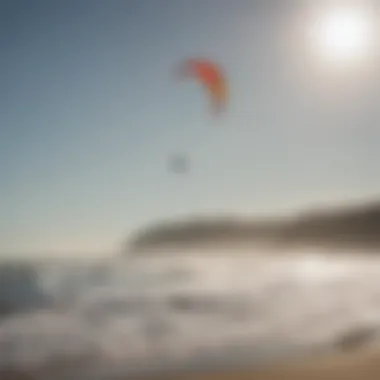
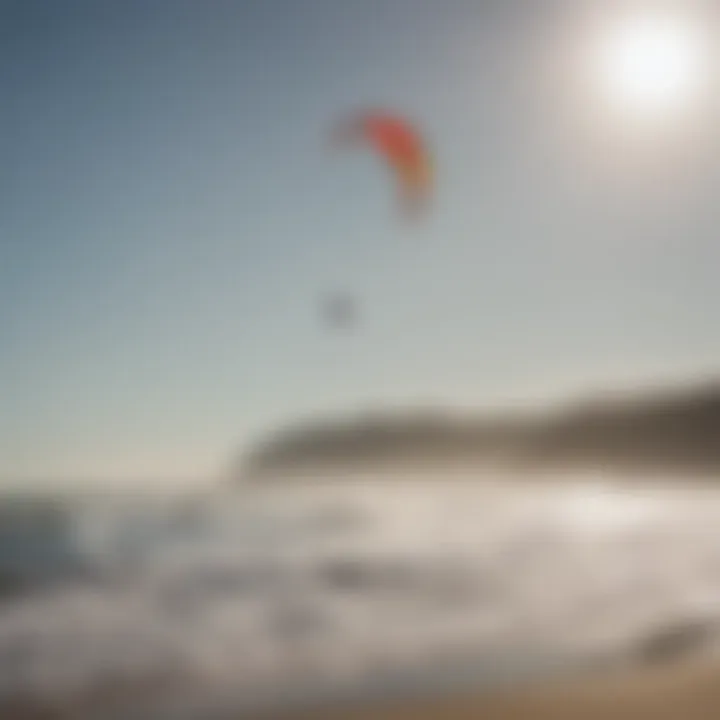
Surfing Waves
Surfing waves is an advanced technique that integrates kite surfing with traditional surfing. This combination amplifies the challenge and enjoyment of riding the waves while allowing surfers to harness the power of the wind in addition to the sea. Understanding the ocean and its dynamics is crucial here.
Key elements for effective wave surfing techniques include:
- Wave Selection: Picking the right wave is essential. Look for waves that are forming nicely without too many obstacles.
- Riding Position: Maintain a low center of gravity for better balance while navigating waves. Position the kite in a stable zone, typically overhead, to maintain speed.
- Turning Techniques: Use the kite to help maneuver while turning. This may involve shifting weight and steering the kite with finesse.
Mastering wave surf techniques allows kite surfers to engage deeply with the environment. Surfers find unique challenges in marine conditions, making each session distinct and exciting.
The blend of jumping and wave surfing techniques significantly elevates an individual's kite surfing experience. With committed practice and understanding of these advanced techniques, kite surfers in San Diego can fully appreciate the multidimensional aspects of their sport.
Community and Culture of Kite Surfing in San Diego
Kite surfing in San Diego is more than just a sport; it embodies a vibrant community and a rich culture that fosters connection and growth among enthusiasts. This culture plays a crucial role in shaping the experiences of both newcomers and seasoned kite surfers. They interact with peers in various settings, from beaches to organized events, creating a sense of belonging. Knowledge is shared freely, fostering an environment that encourages safety, skill enhancement, and mutual respect.
Local Events and Competitions
Local events and competitions cater to kite surfers of all levels, offering an opportunity to showcase skills and learn from others. Popular competitions include the San Diego Kiteboarding Championship, which attracts regional talent and generates excitement among the locals. These events not only highlight individual achievements but also emphasize camaraderie and excitement in the kite surfing community.
Attending these competitions exposes participants to different techniques, styles, and, importantly, the latest gear. For beginners, local events provide insights into what it takes to compete, as well as strategies to improve personal skills. The atmosphere during competitions is inclusive and encouraging, making it an ideal space for those entering the sport.
Kite Surfing Schools and Classes
San Diego is home to various kite surfing schools that offer instruction from basic to advanced levels. Schools like the San Diego Kiteboarding and Surf School provide structured lessons that pay attention to safety and skill development. These institutions foster a learning environment driven by experienced instructors who have a love for the sport. Their passion has a direct impact on the students, motivating them to excel.
In addition to structured lessons, schools often organize group classes, enabling like-minded individuals to connect. Many students form friendships during these practices, often continuing their kite surfing journey together. The educational aspect of the community strengthens bonds and motivates participants to achieve their goals, while also enhancing the local kite surfing culture.
Connecting with Other Enthusiasts
Networking with fellow kite surfers is an essential component of diving deeper into the sport. Social media platforms like Facebook, Instagram, and forums on Reddit serve as a means for kite surfers in San Diego to share experiences, organize meetups, and offer advice.
Connecting with seasoned enthusiasts can provide newcomers with invaluable guidance. This mentorship can vary, from practical advice on technique and gear selections to understanding the nuances of the local conditions. The bonds formed through these interactions create a support system that enhances skill development and enriches the local culture. Overall, active engagement in this community shapes the kite surfing experience in San Diego, making it not just a sport, but a lifestyle.
Environmental Considerations
Kite surfing is not just an engaging sport; it also impacts the environment in several ways. Understanding these environmental considerations is essential for all participants. It ensures not only the preservation of natural resources but also the sustainability of kite surfing itself in San Diego. Kite surfers have the capability to influence the health of local ecosystems through their actions. This section discusses vital aspects like conservation efforts and sustainable practices that kite surfers should adopt to mitigate their impact on the environment.
Conservation Efforts in San Diego
San Diego has rich natural environments, which provide the ideal backdrop for kite surfing. However, these areas also need protection. Many organizations work towards conserving local wildlife and habitats. For example, the San Diego Audubon Society focuses on protecting coastal bird species, while the California Coastal Commission implements policies to maintain safe and healthy beaches.
- Regular beach clean-ups help keep our surfing areas free from debris.
- Participants can dedicate time to volunteering for local conservation groups.
- Advocacy for local environmental policies is essential to protect natural resources.
Collaboration between kite surfers and conservation organizations can create a positive relationship that benefits both groups. Engaging with these initiatives not only helps the environment but fosters a sense of community among surfers and nature lovers alike.
Sustainable Practices for Kite Surfers
Adopting sustainable practices is critical to minimize the ecological footprint of kite surfers. By being mindful of their surroundings, kite surfers can enjoy their sport while protecting the environment. Here are some practices to consider:
- Responsible Kite Handling: Always ensure that kites are packed and secured properly to avoid littering the environment.
- Eco-friendly Gear: Choose brands that prioritize sustainability. This includes equipment made from recycled materials or brands that engage in responsible production practices.
- Avoid Sensitive Areas: Some areas are designated as wildlife reserves. Kite surfers should refrain from launching or landing kites in these regions.
- Educate Others: Encourage fellow surfers to practice conservation and sustainability. Knowledge shared within the community enhances collective awareness.
"Kite surfing offers the thrill of adventure, but we must remember that preserving our environment is an adventure itself."
By being proactive and adopting these sustainable practices, kite surfers can protect the beautiful environment of San Diego. This ensures that future generations can also enjoy kite surfing in this stunning locale.
Future of Kite Surfing in San Diego
The future of kite surfing in San Diego is a topic of growing significance as the sport gains popularity. Understanding the advancements and changes that shape this thrilling activity is essential for enthusiasts and new comers alike. These developments can enhance the experience for kite surfers, push the envelope of what is possible and ensure the sport is enjoyed sustainably.
Emerging Trends and Technologies
Recent years have seen multiple innovations in kite surfing gear and technology. Companies are constantly striving to improve kites, boards, and harnesses. Advances in materials and engineering provide stronger, lighter, and more durable products. Kites are designed with greater stability and control, allowing users to cater their experience to wind conditions. Boards now come with enhanced rocker profiles and flex patterns, enabling better riding performance.
Also, the integration of smartphone apps with kite surfing has started to shape how riders interact with their environment. Applications facilitate tracking wind patterns, wave heights, and even locating the best spots for kite surfing. They create a sense of community where kite surfers can share conditions, tips, and locations. Smart technology is expanding reach of the sport, making it accessible to a wider audience in San Diego.
Potential Challenges Ahead
While advancements present opportunities, challenges remain for the future of kite surfing in San Diego. One significant concern is the environmental impact of increased participation in the sport. More water traffic can disrupt marine life and disturb local ecosystems. Consequently, kite surfers must advocate for and practice responsible kite surfing to minimize their footprint.
Another concern is the potential overreliance on technology. As kite surfing embraces advancements, the human connection to nature and understanding of weather patterns and ocean currents may diminish. This would negatively impact safety and the enjoyment of the sport. Additionally, with commercial interest in the growing trend, ensuring that local kite surfing culture is preserved can be complex.
"Navigating the balance between enjoyment and sustainability is key for the future of the sport."
In summary, the future of kite surfing in San Diego offers both exciting opportunities through technology and emerging trends, as well as challenges that require careful navigation. The ability to embrace the joys of kite surfing while caring for the natural environment is vital for sustaining this engaging sport in San Diego.
Closure
The importance of the conclusion in this article is to encapsulate the central themes surrounding kite surfing in San Diego. It serves as a summation of key insights drawn from our exploration of the sport's historical context, geographical advantages, safety considerations, and community involvement. By reaffirming the relevance of these factors, we acknowledge how they contribute to a more profound understanding of kite surfing, especially for those new to the activity or considering it as a hobby.
Additionally, the conclusion highlights the benefits of engaging with the kite surfing community in San Diego. It emphasizes the essence of local events, training opportunities, and environmentally conscious practices that shape the sport's future. Reflecting on the discussed points, one can appreciate how kite surfing not only offers exhilarating experiences but also fosters a sense of camaraderie among practitioners.
In providing this wrap-up, we encourage readers to not only absorb the information but also to contemplate their role in promoting a sustainable and lively kite surfing culture.
Summary of Key Points
- Overview of Kite Surfing: Kite surfing combines elements of surfing, windsurfing, and paragliding, providing a unique water sports experience.
- San Diego's Attractive Features: The region's favorable climate and varied waterways make it an ideal location for both novices and seasoned surfers.
- Necessary Equipment: Proper gear, including suitable kites and boards, is crucial for safe and enjoyable experiences on the water.
- Safety Precautions: Understanding wind patterns and water navigation is vital for mitigating risks associated with the sport.
- Community Engagement: Local events, training schools, and enthusiasm from other surfers enhance the kite surfing culture in San Diego.
- Environmental Awareness: A commitment to sustainable practices is essential for preserving the natural settings that facilitate kite surfing.
Encouragement to Explore the Sport
For those contemplating the thrilling pursuit of kite surfing, it is essential to embrace the learning journey. Starting small with lessons from certified instructors will provide foundational skills and confidence needed on the water. Moreover, participating in local events or joining a kite surfing club can significantly enhance one’s experience. This provides not just training, but also a supportive network of fellow enthusiasts.
Kite surfing is not merely a sport; it is a lifestyle that promotes interaction with nature, physical fitness, and community connection. As the sport continues to evolve, each participant holds the potential to contribute positively to its culture and environment. Therefore, take the leap and discover the joys of kite surfing in San Diego, where camaraderie, excitement, and stunning landscapes await.







